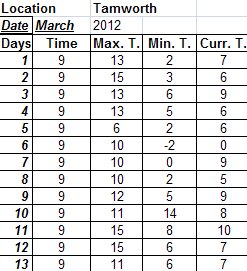Six's Maximum and Minimum Thermometers
You may want to know what the highest (maximum) or lowest (minimum) temperatures have been in the last 24 hours. However you will not want to have to keep reading the thermometer, especially during the night. For this you will need to use a Six's thermometer. There are many sorts. This page tells you about some of them.
The bulb of the sixes thermometer in the Stevenson Screen should be approximately 1.2m (120cm) above the ground.
To see more different thermometers you can go to More About Temperature Readings or you may want to go back to the Temperature Readings page. Alternatively you may want to return to Collecting Data.
Six's ThermometerThe thermometer on the right is a special one for recording maximum and minimum temperatures. All Six's thermometers have one long 'U' shaped tube. This can be clearly seen in the image further down the page. There is a bulb of alcohol at the top of the tube on the left. This cannot be seen on this thermometer. The alcohol expands or contract as the temperature changes. It then push round the indicator liquid to show the temperature. This example has no mercury, and is therefore safer. You get to see the temperature twice, it should show the same temperature on both scales. Both Celsius scales show 19 °C. |
 |
The Marker PinsSo that the Maximum (hottest) and Minimum (coldest) temperatures can keep be recorded there are two small steel pins. |
 |
Reading the ScalesThe close-up of a part of the scales on the right shows how they are reversed. |
 |
Resetting a Six's ThermometerThere are different ways of resetting the thermometer so that the pins move back to the current temperature.This is done at 09.00 GMT in the United Kingdom. Elsewhere it is 09.00 local time. Some thermometers simply have a little magnet which is used to pull the pins back down. On other Six's thermometers when a button is pressed a similar thing happens. See a video of resetting by pressing a button. |
|
Caring for a Six's ThermometerAs with most weather instruments you need to treat a Six's thermometer very carefully. There are glass parts which can be easily broken. If any instrument gets broken seek advice from an adult immediately. |
|
Error CheckingWhen you record your data from your sixes thermometers you will record three numbers. These are the maximum and minimum temperatures and the current temperature. The highest number will be the maximum, the lowest the minimum, and the current temperature will be somewhere in between. Once you have recorded the number take a moment to check that they are in the right boxes. Can you see any incorrectly typed number on the right? |
 |
James Six (1731 - 1793) This is called a Six's thermometer because
it was invented by a man called James Six.He was born in Canterbury and did some scientific experiments in the cathedral. The picture on the right shows this beautiful cathedral. |
 |
Why record Maximums and Minimums?Most people love record breakers. If you only record the temperature when you are looking at your thermometer you might miss a record breaking temperature, either a maximum or a minimum. If you have a Sixes Thermometer, or a digital maximum and minimum thermometer you will record the highest and lowest temperature whatever time they occur. |
Please Note
Please be conscious of any safety issues regarding these activities. It may be advisable to avoid any instruments which contain mercury.

